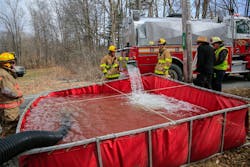It’s 10 a.m. on a weekday in a small, rural town. The calm of the day is interrupted for a call of assistance to a neighboring jurisdiction for a residential structure fire. Does this scenario sound familiar? Is your response area considered rural?
Maybe your area is considered suburban, but you have areas that are considered more rural by definition.
Of course, all departments face challenges, but the rural fire service faces ordeals that our more urban brothers and sisters might not encounter. On scene, the first 10 minutes is the biggest test that a rural department faces, in the form of response of adequate personnel, prepared incident command, efficient fire attack and adequate water supply.
The response
Response of equipment and needed personnel should be an automated process. By automating the response details, the incident commander (IC) could be in a better position to focus on managing the incident. The way to accomplish the former is through established standard operating procedures (SOPs) and technology.
The use of duty staffing is the best way to know the exact number of responding personnel on the first out apparatus. In addition, phone apps allow responding firefighters to know exactly how many units are responding, along with incident details, such as address, hydrant locations and additional call notes that the dispatcher obtains after the initial call.
The use of automatic mutual aid assists departments to fill gaps in needed equipment and personnel. However, these aid agreements don’t happen overnight. They must be discussed with each department’s leadership and agreed upon in writing prior to implementation. They include:
- Amount of resources that each department provides for each type of call;
- Training that’s required of responding units;
- SOPs to utilize; and
- Liability and payment of services, if necessary.
Incident command and size-up
Urban and rural incident command differ in numerous ways. In an urban/paid setting, the IC is dedicated to his/her work, meaning that he/she has the personnel to pull handlines, establish water supply, and conduct search and rescue. In the rural/volunteer setting, the person who is the IC also could be the individual who pulls handlines, actively fights the fire or operates the apparatus. Unsurprisingly, this reduces rural responders’ ability to focus on the role of incident command. This also can lead to lost radio transmissions and incomplete critical command items. This inhibits command, control and accountability during the emergency incident. An additional complication: In a rural/volunteer setting, the IC might not be an officer or could be the newest firefighter on the fire department.
To reduce the danger that’s inherent to this situation, it’s imperative that departments establish basic incident command and control training early in a rural/volunteer firefighter’s career. The utilization of checklists and command boards can assist the young IC in making correct decisions. Also, if an inexperienced firefighter finds him/herself in the role of IC and an officer or more experienced firefighter arrives on scene from another agency, the inexperienced firefighter shouldn’t be reluctant to pass command to the newly arriving individual.
In an urban/suburban structure fire, the initial size-up and 360-degree walkaround very well might be able to be completed upon arrival. This is because of street layouts and the ability to see three sides as you drive past the structure. A quick walk down the Bravo or Delta side of the structure, and the 360 is complete.
In a rural/volunteer setting, members might need to drive up a long, single-lane driveway. This gives the initial responders only one view and requires them to make a true hot lap around the structure to complete the 360. That said, steep terrain, wooded areas and loose animals could present challenges to completing a full size-up. Because rural houses can be very large, the completion of a 360 could be made nearly impossible, considering the prospect that the incident is occurring on a 5,000-square-foot-plus area.
Lengthy response times, long distances, reduced manpower and inadequate water supply place rural departments in a predicament that requires them to think differently than urban/suburban departments about tactics and the way that their attack apparatus is set up. The primary goal of the rural department should be fast, efficient water on the fire.
The attack apparatus is the centerpiece of all fireground operations. It needs to be set up to handle the largest fires that the district could encounter. By doing this, it will be able to handle 95 percent of the actual fires it will respond to.
Three basic fire attack setups need to be in place on the apparatus: small, medium and large. Because rural agencies regularly face reduced personnel situations, each of these setups must be able to be put in place and operated by one member.
The small attack line setup needs to be a minimum of a 1¾-inch hoseline that’s capable of flowing at least 150 gpm. This attack setup is utilized for one- and two-room fires. If a department has two crosslays and each has this setup, it will meet the NFPA minimum of having 300 gpm on the initial and backup attack line. (A modified minuteman load of 200 feet of attack line requires still only one firefighter to deploy.) Setting each attack line to the same gallons per minute and nozzle tip pressure improves pump operations by having the same discharge pressures on each crosslay.
The medium attack line setup is for three-, four- and five-room fires or very large areas. The attack line needs to be 2½ inches and 200 feet in length preconnected. Most departments have this attack line coming off of the rear of the apparatus. The nozzle for this line should be a smooth bore that’s capable of flowing a minimum of 265 gpm. A preference of some departments is a smooth bore nozzle that allows for: greater gallons per minute; greater penetration; and less nozzle reaction.
The large attack line comes in the form of either a deck gun monitor or a preconnected ground monitor. The large attack line must be capable of flowing 500–1,500 gpm. This is for those fires that are beyond the capabilities of the medium attack line or that need quick water application.
Sometimes, departments are hesitant to put large handlines in service because of the initial water supply that’s available. However, departments often fail to realize the firefighting power of the larger-diameter handlines over the smaller ones. If one firefighter flows 500 gpm for 30 seconds and extinguishes most of the fire, he/she used 250 gallons. If one firefighter utilizes a smaller handline that flows 150 gpm to conserve water, but it takes 10 minutes to extinguish the majority of the fire, he/she uses 1,500 gallons. Which is better for water supply?
Water supply
One of the biggest differences between the rural and urban firegrounds probably is available water supply. Rural area departments might have only one hydrant for the entire district versus every 500 feet in the urban setting. So, a rural department must rely on alternative methods of supply, such as the use of tankers and tanker shuttles.
The needed amount of tankers and water supply is determined by utilizing the National Fire Academy fire flow formula of length x width divided by 3 to get a required gallons per minute that’s based on a one-hour duration. For example, a 1,500-square-foot residence needs 500 gpm, or a total water supply of 30,000 gallons. If each tanker carries 2,000 gallons, the IC either will need 15 tankers or 8 tankers that make two trips or 5 tankers that make three trips.
Some recommendations when it comes to water supply:
- Preplan your area and divide it into zones and predetermine fill sites;
- Set up tankers with quick couplings for fast load and offload of water;
- Utilize experienced drivers because of the size and weight of tanker apparatus; and
- Utilize dump tanks to speed tanker turnaround time.
Challenges met
As you prepare for the challenges of the first 10 minutes of the rural fireground, think about how your department is currently set up. Is it set up for quick, efficient water? Is it set up for the right amount of resources to respond to the incident? Is it set up with a capable IC to be able to manage those resources?
With great preplanning and training, you and your department can be prepared for the challenges of the rural fireground.
Rural Size-Up
Typical circumstances that a rural/volunteer fire department encounters upon arriving on scene of an incident can inhibit the 360-degree size-up. As such, departments’ standard operating procedures should include:
- Utilize other firefighters or even other responding emergency services, such as police and EMS personnel, to serve as scouts to give you information;
- Preplan target hazards prior to incidents to have a familiarity with the building; and
- Utilizing technology, such as drones, on large McMansion-type homes, commercial facilities and wildland fires, allows the incident commander to see the entire picture without having to physically make the 360-degree size-up lap.
About the Author

Justin Bailey
Justin Bailey is the fire chief of the Oliver Springs, TN, Fire Department and a 20-year student of the fire service. He also holds the rank of master firefighter with the Knoxville, TN, Fire Department, where he has served since 2007. Bailey has an associate degree in allied health science from Roane State Community College and a bachelor's degree in fire administration from Columbia Southern University. He speaks regionally and nationally on the topics of volunteer training program development, professional development and rural fireground management.

